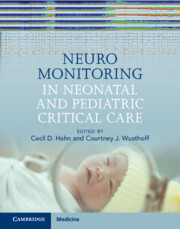Book contents
- Neuromonitoring in Neonatal and Pediatric Critical Care
- Reviews
- Neuromonitoring in Neonatal and Pediatric Critical Care
- Copyright page
- Contents
- Contributors
- Acknowledgements
- Part I General Considerations in Neuromonitoring
- Chapter 1 Overview of Continuous EEG Monitoring in Critically Ill Neonates and Children
- Chapter 2 Technical Aspects of Neurophysiological Monitoring
- Chapter 3 Logistics of Neuromonitoring
- Chapter 4 Nursing Considerations in Neuromonitoring
- Chapter 5 Normal Neurophysiology, Benign Findings, and Artifacts
- Chapter 6 Abnormal EEG in the Intensive Care Unit
- Part II Practice of Neuromonitoring: Neonatal Intensive Care Unit
- Part III Practice of Neuromonitoring: Pediatric Intensive Care Unit
- Part IV Practice of Neuromonitoring: Cardiac Intensive Care Unit
- Part V Cases
- Index
- References
Chapter 5 - Normal Neurophysiology, Benign Findings, and Artifacts
from Part I - General Considerations in Neuromonitoring
Published online by Cambridge University Press: 08 September 2022
- Neuromonitoring in Neonatal and Pediatric Critical Care
- Reviews
- Neuromonitoring in Neonatal and Pediatric Critical Care
- Copyright page
- Contents
- Contributors
- Acknowledgements
- Part I General Considerations in Neuromonitoring
- Chapter 1 Overview of Continuous EEG Monitoring in Critically Ill Neonates and Children
- Chapter 2 Technical Aspects of Neurophysiological Monitoring
- Chapter 3 Logistics of Neuromonitoring
- Chapter 4 Nursing Considerations in Neuromonitoring
- Chapter 5 Normal Neurophysiology, Benign Findings, and Artifacts
- Chapter 6 Abnormal EEG in the Intensive Care Unit
- Part II Practice of Neuromonitoring: Neonatal Intensive Care Unit
- Part III Practice of Neuromonitoring: Pediatric Intensive Care Unit
- Part IV Practice of Neuromonitoring: Cardiac Intensive Care Unit
- Part V Cases
- Index
- References
Summary
Recognizing a normal recording is the first, but not the simplest, step of EEG analysis. Normal EEG patterns evolve in a predictable, age-dependent manner. In reviewing EEG and qEEG trends, clinicians must identify normal patterns and common artifacts that may mimic seizures or other abnormalities. This chapter provides a guide for practitioners reviewing neonatal and pediatric EEG to help recognize normal tracings. Instruction is given for how to systematically approach EEG and QEEG analysis. Age-specific aspects are reviewed with example findings. Common artifacts are shown.
Keywords
- Type
- Chapter
- Information
- Neuromonitoring in Neonatal and Pediatric Critical Care , pp. 48 - 75Publisher: Cambridge University PressPrint publication year: 2022



